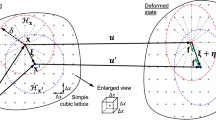Abstract
A dislocation simulation model has been proposed to predict the brittle–ductile transition in ferritic steels in Part I. Here we extend the model to address the problem of inherent scatter in fracture toughness measurements. We carried out a series of Monte Carlo simulations using distributions of microcracks situated on the plane of a main macrocrack. Detailed statistical analysis of the simulation results showed the following: (a) fracture is initiated at one of the microcracks whose size is at the tail of the size distribution function, and (b) the inherent scatter arises from the distribution in the size of the critical microcrack that initiates the fracture and not from the variation of the location of the critical microcrack. Utilizing the weakest-link theory, Weibull analysis shows good agreement with the Weibull modulus values obtained from fracture toughness measurements.






Similar content being viewed by others
References
Anderson, T.L., Stienstra, D., Dodds, R.H. Jr.: Theoretical framework for addressing fracture in the ductile-brittle transition region. In: Landes, J.D., McCabe, D., Boulet, J.A.M. (eds.) Fracture Mechanics: Twenty-fourth Volume, pp. 186–214. ASTM Philadelphia, PA, STP 1207 (1994)
Beremin, F.M.: Local criterion for cleavage fracture of a nuclear pressure vessel steel. Metall. Trans. 14, 2277–2287 (1983)
Bowen, P., Druce, S.G., Knott, J.F.: Effects of microstructure on cleavage fracture in pressure vessel steel. Acta Metall. 35, 1121–1131 (1987)
Chen, J.H., Chu, L., Wang, G.Z., Wang, Z.: Further investigation of critical events in cleavage fracture of C-Mn base and weld steel. Metall. Trans. A 24, 659–667 (1993)
Curry, D.A., Knott, J.F.: Relationship between fracture toughness and microstructure in the cleavage fracture of mild steel. Metal Sci. 10, 1–6 (1976)
Curry, D.A., Knott, J.F.: Effects of microstructure on cleavage fracture stress in steel. Metal Sci. 12, 511–514 (1978)
Curry, D.A., Knott, J.F.: Effect of microstructure on cleavage fracture toughness of quenched and tempered steels. Metal Sci. 13, 341–345 (1979)
Hirsch, P.B., Roberts, S.G.: Modelling crack tip plastic zones and the brittle-ductile transition. Phil. Trans. R. Soc. Lond. A. 355, 1991–2001 (1997)
Jayatilaka, A.DeS., Trustrum, K.: Statistical approach to brittle fracture. J. Mater. Sci. 12, 1426–1430 (1977)
Knott, J.F.: The Micro-mechanisms of Fracture in Steels used for high integrity structural components. In: Hirsch, P.B., Lidbury, D. (eds.) Fracture, Plastic Flow and Structural Integrity, pp. 21–43. IOM Communications Ltd, London (2000)
McMahon, C.J. Jr., Cohen, M.: Initiation of cleavage in polycrystalline iron. Acta Metall. 13, 591–604 (1965)
Noronha, S.J., Ghoniem, N.M.: Brittle-ductile transition in F82H and effects of irradiation. J. Nucl. Mater. 367–370, 610–615 (2007)
Ortner, S.R., Hippsley, C.A.: Two component description of ductile to brittle transition in ferritic steel. Mater. Sci. Technol. 12, 1035–1042 (1996)
Poloniecki, J.D., Wilshaw, T.R.: Glass surface cracks-Hertzian fracture data and a new analytical method. Nat. Phys. Sci. 229, 226–227 (1971)
Press, W.H., Teukolsky, S.A., Vellerling, W.T., Flannery, B.P.: Numerical Recipies. Cambridge University Press (1996)
Roberts, S.G., Noronha, S.J., Wilkinson, A.J., Hirsch, P.B.: Modelling the initiation of cleavage fracture of ferritic steels. Acta Mater. 50, 1229–1244 (2002)
Wallin, K.: Scatter in KIc-results. Eng. Fract. Mech. 19, 1085–1093 (1984)
Wallin, K., Saario, T., Törrönen, K.: Micromechanism based statistical model for brittle fracture. Metal Sci. 18, 13–16 (1984)
Zerilli, F.J., Armstrong, R.W.: Dislocation-mechanics-based constitutive relations for material dynamics calculations. J. Appl. Phys. 61, 1816–1825 (1987)
Acknowledgements
Support by the U S Department of Energy, Office of Fusion and Nuclear Energy through Grants DE-FG02-03ER54708 and DE-FC07-06ID14748 are gratefully acknowledged.
Author information
Authors and Affiliations
Corresponding author
Appendix
Appendix
To estimate the three parameters in Eq. 2 we proceed as follows: the fracture toughness (K F ) estimated numerically from our model is first ranked in an ascending order. The range of data is then divided into four equal classes and a histogram of probability density function (PDF) f is plotted. (The class value is represented by the mean of this range.) The density f of the class is the number of K F in the ith class n i divided by the product of the sample N and the class width w. The cumulative density function (CDF) is the area under the histogram up to the class,
where w i is the width of the class with rank i and probability density f i . At first, we assume K c = 0; then from the plot of lnln(1/1 − P) versus ln(K F /K 0) (see e.g. Fig. A1) then, we can estimate K c as follows.
We first locate three points A, B, C such that they are equally spaced along the ordinate or lnln(1/(1−P)) axis, thus by construction, we have
or the displacements from origin are given as
Taking the logarithm twice of Eq. 2 yields
Now substituting the (A3) (A2), we obtain,
Now we compute a new set of data points using (K F −K c ) and replot lnln(1/(1−P)) (see Fig. A2). The curve becomes linear implying that the data is indeed Weibullian. The slope of this line gives the Weibull modulus and the characteristic value (K 0) can be obtained from the value of ln(K F −K c ) corresponding to lnln(1/(1−P)).
Rights and permissions
About this article
Cite this article
Noronha, S.J., Ghoniem, N.M. Modeling the brittle–ductile transition in ferritic steels. Part II: analysis of scatter in fracture toughness. Int J Mech Mater Des 4, 13–20 (2008). https://doi.org/10.1007/s10999-007-9042-2
Received:
Accepted:
Published:
Issue Date:
DOI: https://doi.org/10.1007/s10999-007-9042-2






